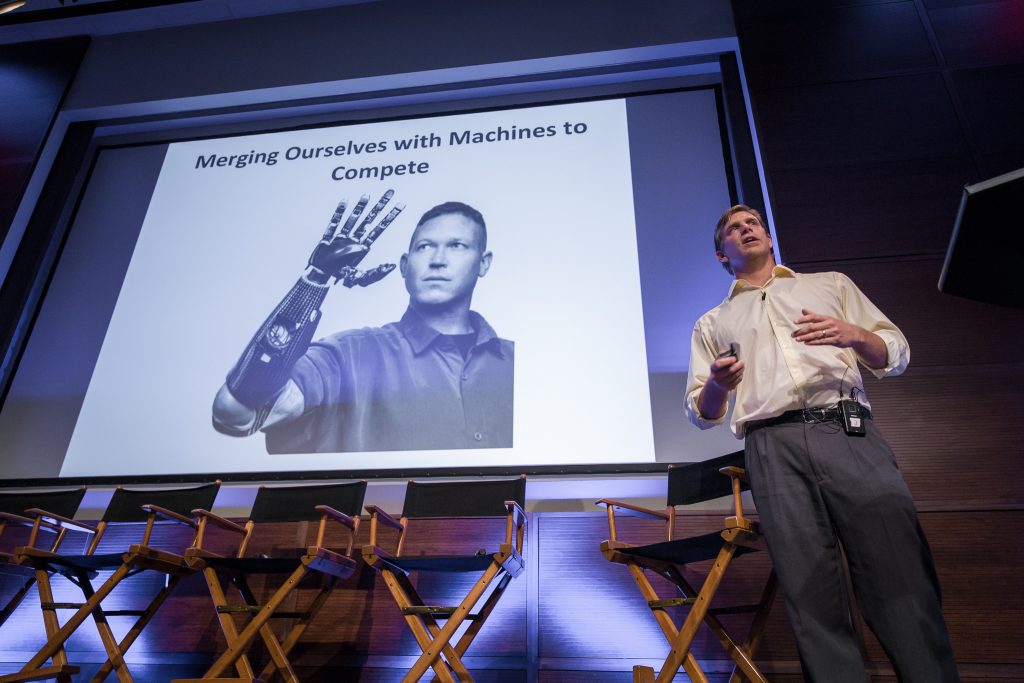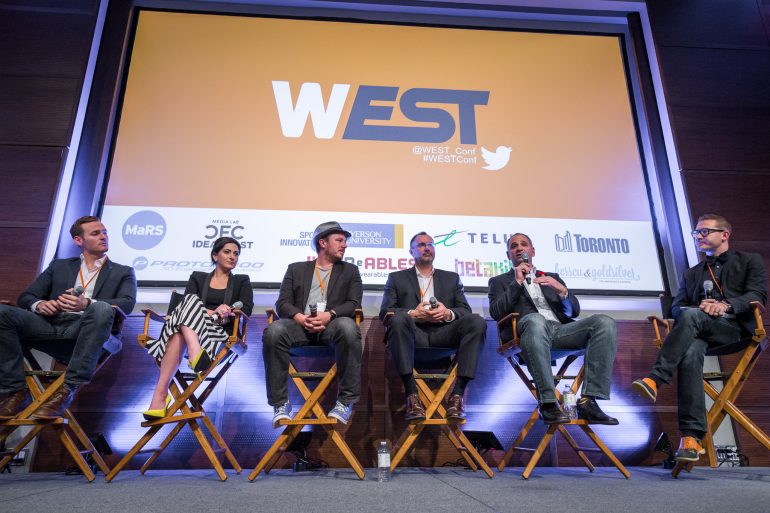“Wearable technology is really rooted in the human experience,” said Tom Emrich, founder of We Are Wearables and BetaKit senior editor. “And our human experience has always been shaped by sports, entertainment, and media.”
The crowd at the sold-out event listened as Emrich described how WEST Conference, on for the second year in a row, would explore the future of entertainment and sports, with a packed day of talks from experts — coming from as far as Japan and Australia — in the gaming, toy, sports, and film industries.
With film and television two obvious areas of focus for wearable technology, WEST panelists were keen to discuss the concerns of adapting to a new medium. “I think the challenge is to get beyond technology, as the experience should be a big part of the narrative,” said Jody Sugrue, director of digital at TIFF. “The big challenge is that there’s no one behind the camera, and you’re going to have to give up a sense of control over the story, and be okay with people looking wherever they choose. Script writers will become world builders.”
Beyond the fictional worlds we hope to explore, WEST also focused on the role of wearables to augment the world we already live in. Billie Whitehouse is the co-founder of Wearable Experiments, a design house for wearable products, and the company behind the Fundawear campaign, a set of vibrating underwear for long distance couples. For Whitehouse, that augmentation can come from returning something lost.
“I think I’m more of an anthropologist, I sit and study people and I design with emotions,” said Whitehouse. “We’ve gotten to this point in time that you have to be emotional in this world because technology absolutely strips that out. Yes it is data, but you have to keep it an emotional experience for people to remember. People aren’t designing for all five senses, they’re designing for only three.”
Whitehouse also emphasized that the term wearables could be a barrier to entry for people who are not necessarily early adopters of tech. “This is ready-to-wear, it’s a brand of clothing,” Whitehouse said, pointing out that women interested in fashion look more at the design and sustainability aspects, rather than specs or features.
Crazy stat. Women comprise 70% of all purchases ever made, but not being targeted by tech. #WESTConf
— Douglas Tr0n Soltys (@tron) November 3, 2015
The sports side of the WEST conversation tackled how professional sports could allow audiences who wouldn’t otherwise be able to be at a game to indulge via VR. “There is a social aspect where people go to a party or bar, and they watch a game and share the experience—we’re not trying to replace the experience, we’re trying to enhance it,” said Lance Loesberg, founder and CEO of BigLook360. “There are also talks coming up of being able to communicate in that world, so that there can be P2P experiences.”
“Why don’t we suit up Bay Streeters with wearables? Why are we [pro athletes] being dehumanized at the cost of analytics?”
-Brian Bulcke, defensive lineman for the Hamilton Tiger-Cats
As with any emerging technology, there were concerns about who exactly would benefit from the analytic capabilities of wearable tech — and whether some might be disadvantaged. Brian Bulcke, the defensive lineman for the Hamilton Tiger-Cats, as he has in the past, explained that wearables are a contentious issue among athletes. With general managers of sports teams in the business of making money, Bulcke’s concern is that sleep and nutrition analytics will be used to an Orwellian degree. “Why are pro athletes the guinea pigs for all of this emerging technology?” asked Bulcke. “Why don’t we suit up Bay Streeters with wearables? Why are we being dehumanized at the cost of analytics?”
But Paul Robbins, director of Elite Performance at STATS LLC, disagreed that analytics were against an athlete’s best interest. “Understanding how certain people slept would help me determine how they should warm up, and with nutrition, most meals are catered to them, but how well do they truly eat?” asked Robbins. “They have to understand that we’re doing this for them, so they can sign that $10 million contract.”

Following Emrich’s penchant for forward-looking speakers, the day-long event finished off with an appearance from Zoltan Istvan, the 2016 U.S. presidential candidate for the Transhumanist Party. Istvan talked about surgically implanting a chip into his hand, inventing a sport by snowboarding down the side of an active volcano, and the inevitability of a Transhumanist Olympics as technology continues to enhance performance.
“It has to do with our very nature of becoming a different species,” said Istvan, arguing that artificial hearts and bionic arms will only make humans healthier, faster, and stronger. Eventually, we will have to redefine competitive sports —and redefine what makes us human. “It’s not going to be able athletes anymore. It’s going to be about the science and engineers developing the technology. It will be like Formula One racing.”
Photo courtesy Billy Lee


